Cidade do Porto
City of Porto
[Port]
O Porto é um dos destinos turísticos mais antigos da Europa e a riqueza do seu património artístico, o Vinho do Porto, os vastos espaços dedicados ao lazer e a sua vida cultural são apenas alguns dos motivos que convidam a visitar a cidade.
Ao longo do rio e do mar a cidade desdobra-se em paisagens encantadoras, esplanadas convidativas e o prazer do ar livre, que os espaços verdes complementam. Mas descobrir o Porto é ir ao encontro de muitas surpresas. Mantendo o seu caráter hospitaleiro e conservador, a cidade é, também, contemporânea e criativa, e de tudo isto dão testemunho as ruas, a arquitetura, os museus, os espaços de lazer, as esplanadas e as zonas comerciais, das mais tradicionais a espaços modernos e exclusivos.
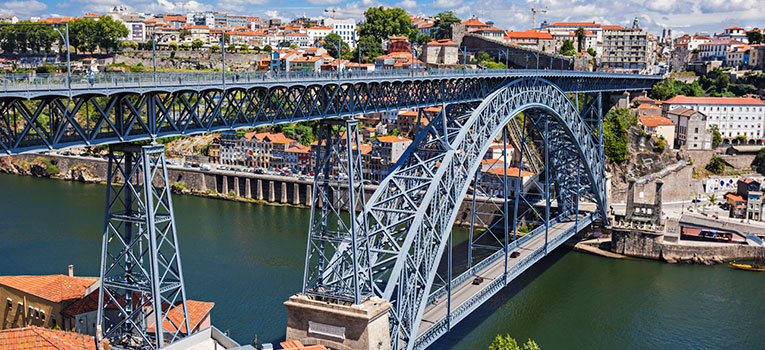
O Centro Histórico do Porto é Património Cultural da Humanidade desde 1996 e o seu enquadramento paisagístico e o traçado sinuoso das suas ruas conferem-lhe uma beleza singular.
Na cidade o Vinho do Porto está presente de várias formas e sentidos: pode ser conhecido e experimentado, mas jamais ignorado, ou esquecido.
Testemunha de uma história feita do cruzamento de culturas em sucessivas ocupações, várias vezes invadida e cercada, mas sempre Invicta, a cidade do Porto é património vivo, dinâmico, que se regenera e se reinventa, mantendo sempre o seu caráter, ou não fosse alicerçado em granito e por conseguinte, inabalável.
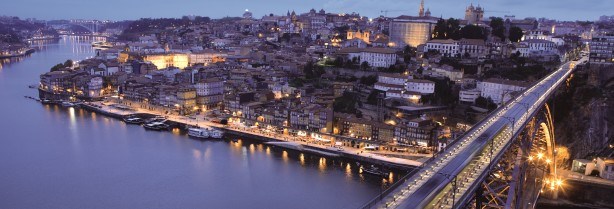 [Ingl]
[Ingl]
This is one of Europe's oldest tourist destinations. Its wealth of artistic heritage, Port Wine, open-air leisure spaces and cultural life are just some of the reasons to visit this city.
The city unfolds along the river bank and the sea shore, to reveal charming vistas, inviting esplanades and all the pleasures of the outdoors, framed by its green spaces. But setting out to discover Porto means bumping into surprise after surprise. Whilst maintaining its welcoming and conservative nature, the city is, at the same time, contemporary and creative. This can be seen in its streets, its architectures, its museums, its leisure spaces, its esplanades and its shopping areas which run from the traditional to the modern and exclusive.

Porto’s Historical Centre was designated World Cultural Heritage in 1996 and its natural setting and its meandering streets give it a unique charm.
Port wine is present in the city in a multitude of forms and sensations: you can get to know it and try it, but never ignore it or forget it.
Having witnessed a long history of cultural ebbs, flows and eddies caused by successive waves of occupation, and often surrounded and invaded, but always remaining Invicta (unbowed), the city of Porto is really a living heritage, one that regenerates and reinvents itself, whilst maintaining its core character, grounded in granite and, thus, unshakeable.
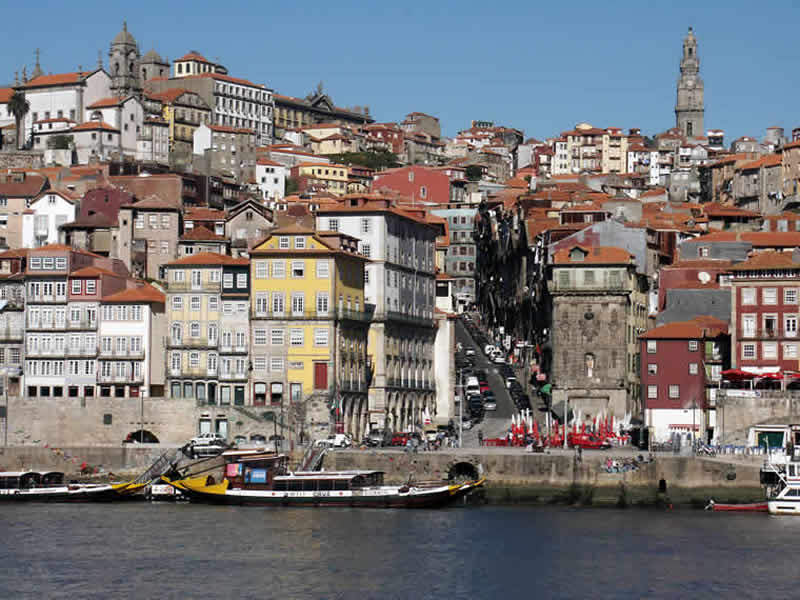
Classificação da Unesco
Unesco´s classification
[Port]
As características singulares do centro histórico do Porto fizeram com que a UNESCO o classificasse como "Património Cultural da Humanidade", em dezembro de 1996. A classificação teve como objeto a área do burgo medieval, limitada pelas muralhas do século XIV. Aí se localizam os mais antigos edifícios da cidade, as suas típicas ruas e alguns dos mais atrativos espaços públicos. O desenvolvimento do Porto foi um processo acompanhado de estreitas relações com a margem esquerda do Rio Douro, a proposta de classificação inclui ainda a emblemática Ponte D. Luis I, da autoria de um discípulo de Gustavo Eiffel - Theophile Seyrig - e, o monumento que lhe fica sobranceiro, o convento Agostinho da Serra do Pilar.
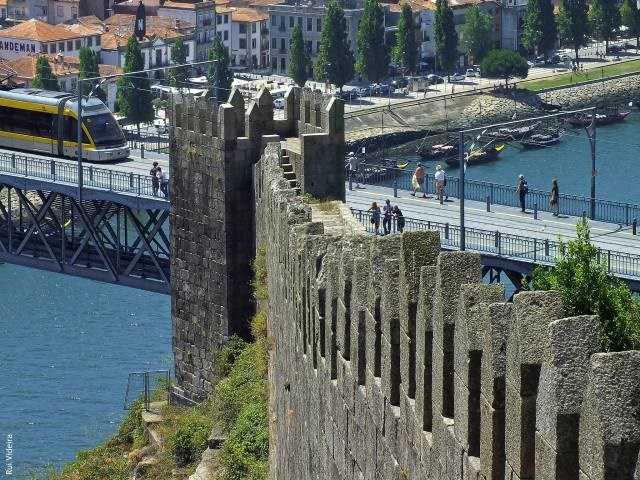
A área de proteção coincide praticamente com os antigos arrabaldes da cidade medieval, tanto do lado do Porto, como de Vila Nova de Gaia. Esta última inclui a encosta em anfiteatro, onde se implantam as caves do Vinho do Porto. Da margem norte, fazem parte a velha freguesia de Miragaia, a qualificada cintura setentrional, cuja renovação se iniciou a partir do século XVIII, o arrabalde antigo de Santo Ildefonso e a escarpa dos Guindas e das Fontainhas que, em socalcos, desce até ao Rio Douro.
[Ingl]
Considering the unique features of Porto’s historical centre, it was classified by the UNESCO as “World Cultural Heritage” in December 1996. The classified area comprises the medieval borough located inside the fourteenth-century Romanesque wall. It includes the oldest buildings in the city, as well as typical streets and attractive public areas. The development of Porto was closely connected with the left margin of River Douro, and the proposal included the highly significant Luís I Bridge, designed by the architect Théophile Seyrig (a disciple of Gustav Eiffel), and the prominent building of the Augustinian Convent of Serra do Pilar.
The protection area corresponds to the former outskirts of the medieval city on both sides of the river. In Vila Nova de Gaia, this area includes the amphitheater-shaped slope where the Port Wine cellars are located. On the north margin, it comprises the ancient borough of Miragaia, the northern belt whose renovation was begun in the eighteenth century, the ancient area of Santo Ildefonso, the slopes of Guindais and the terraces of Fontaínhas that descend towards the River Douro.
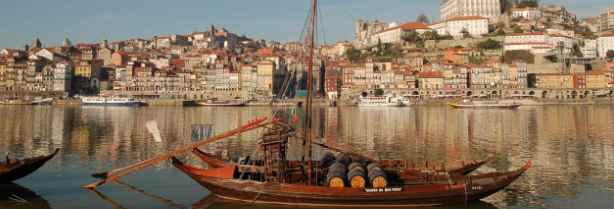
O Vinho do Porto
Porto Wine
O Vinho do Porto é um vinho generoso, produzido exclusivamente na Região Demarcada do Douro, envelhecido nas caves de Gaia e exportado a partir do Porto, para todo o mundo. Deve as suas inconfundíveis características de aroma, corpo e sabor à alta qualidade das uvas, bem como às características agroclimáticas da região. "Vinho do Porto" é essencialmente uma designação geográfica de origem.
Há, na verdade, vários tipos de Vinho do Porto: uns envelhecem em vasilhas de madeira, outros na garrafa. Os primeiros são geralmente o resultado de sábias lotações entre colheitas de anos diferentes, de modo a manter a vitalidade do vinho e a dar continuidade ao estilo e marca. Regra geral não ostentam no rótulo data ou ano de nascença. Os segundos provêm geralmente de uma só colheita.
Em linhas gerais são os seguintes os principais tipos existentes no mercado:

As Caves do Vinho do Porto
As caves de Vinho do Porto são o local privilegiado para tomar contacto com esta bebida nacional e toda a sua história. Abertas ao público, oferecem a oportunidade de degustar este precioso néctar, conhecer o seu percurso ao longo dos tempos, a região onde é produzido e a forma como é obtido.
O Instituto dos Vinhos do Douro e Porto
Criado em 1933, o Instituto dos Vinhos do Douro e Porto é a entidade responsável pela certificação e fiscalização da Denominação de Origem “Porto”, controlando a qualidade e quantidade dos vinhos suscetíveis da obtenção da Denominação de Origem, através da regulamentação do seu processo produtivo e da submissão prévia a um rigoroso controlo de qualidade, efetuado pelos seus Serviços Técnicos. Após ser aprovado, o vinho adquire o direito ao uso da denominação “Porto”, ao Selo de Garantia e ao Certificado de Denominação de Origem, todos emitidos pelo Instituto dos Vinhos do Douro e Porto.
O Instituto tem também como atribuição, para além da certificação e fiscalização, a defesa da “Denominação de Origem” e o apoio à expansão do comércio nos mercados consumidores através da promoção genérica do Vinho do Porto a nível mundial.
[Ingl]
Port Wine is a sweet fortified wine, exclusively produced in the Douro designated region, aged in the cellars in Gaia and exported from Porto all over the world. Its unmistakable bouquet, body and flavour are due to the high quality of the grapes, as well as to the region's soil and clima. "Port Wine" is basically a geographic name of origin.
There are, in fact, different types of Port Wine - some are aged in wooden casks and others in bottles. The former are usually the result of a skillful blending of wines from different harvests, in order to keep the wine's vitality and to provide it with homogeneous characteristics. As a rule the label has no indication of date or vintage. The latter are produced from one harvest only.
The following are the main types found in the market:
Port Wine Cellars
The Port Wine Cellars are the perfect spot to get in touch with this national drink and its history. They offer the public the opportunity of tasting this precious nectar, knowing its course over the ages, the region where it is produced and the way it is made.
Douro and Port Wines Institute
The Port and Douro Wines Institute was established in 1933 to be the entity responsible for the certification and control of the “Port” Appellation of Origin. It controls the quality and the quantity of the wines likely to achieve this Appellation of Origin by regulating its production process, as well as its previous submission to a strict quality control performed by its technical department.
After the approval the wine is allowed to carry the “Porto” appellation, the guarantee seal and the Appellation of Origin label, all issued by the Porto and Douro Wines Institute.
The Institute also aims at defending the appellation of origin and supporting the development of the trade within the consuming markets through the generic worldwide promotion of Port Wine, besides certification and control.
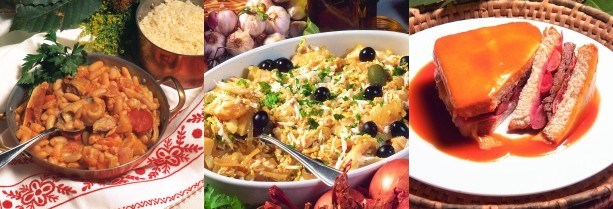
Gastronomia
Food
A gastronomia do Porto é um espelho da sua riqueza cultural. São várias as histórias associadas, várias as lendas contadas de geração em geração e que hoje completam os costumes das gentes da cidade. Entre os que maior fama detém, os pratos típicos portuenses caraterizam-se tanto pelo incomparável paladar, como pela particularidade da sua confeção.
Tripas à Moda do Porto
Prato que deu nome aos habitantes da cidade: “Tripeiros”. Conta a lenda que, quando no séc. XV o Infante D. Henrique partiu do Porto à conquista de Ceuta, o povo, pleno de altruísmo, cedeu toda a carne às tropas ficando apenas com as tripas. Mas a irreverência portuense permitiu dissipar tal adversidade: cozinharam-se as tripas em estufado e surgiu assim este apetitoso prato típico.
Bacalhau à Gomes de Sá
“João se alterar qualquer cousa já não fica capaz”, disse Gomes de Sá quando cedeu a receita original ao amigo, em finais do séc. XIX. Com um toque especial e quase os mesmos ingredientes com que preparava os bolinhos de bacalhau, para deleite dos amigos, este gastrónomo do Porto eternizou a forma de preparar tão saboroso e original prato de bacalhau.
Francesinha
Foi em 1953 que Daniel da Silva, combinando o conceito de alguns snacks franceses e acrescentando o molho picante de sua autoria, criou esta iguaria, atribuindo-lhe tal nome em honra da “mulher mais picante” que conhecia, a francesa. O molho que cobre a sandes de carne e enchidos é mesmo o segredo deste tentador capricho. Verdadeiro pitéu portuense, pode ser apreciado em grande parte dos restaurantes e cafés da cidade.
Cozinha contemporânea
Mas o tradicional não define o limite da cozinha do Porto. A cidade é, também, montra de Chefs de requintada qualidade, alguns de renome internacional, que a colocam na vanguarda da cozinha moderna. Não deixe de experimentar, com certeza será surpreendido!
[Ingl]
Porto’s gastronomy is a mirror of its cultural diversity. There are several stories about it, several legends told from generation to generation, which today complete the traditions of the townsfolk. Among the most famous ones, the typical dishes from Porto are characterized both by its incomparable taste and the uniqueness of its making.
Tripas à Moda do Porto (Porto Style Tripe)
Dish that named the townspeople “Tripeiros” (Tripe People). Legend has it that, when in the fifteenth century the Infante D. Henrique(Prince Henry, the Navigator) left from Porto to conquer Ceuta, the people from Porto, full of selflessness, gave all the meat to the troops and were left just with the guts and tripe. But the city’s irreverence allowed dissipating such adversity: the guts and tripe were cooked in a stew and thus this tasty typical dish appeared.
Bacalhau à Gomes de Sá (Gomes de Sá Cod)
“João, if you change anything it won’t be good“, said Gomes de Sá when handing the original receipt to his friend, in the late nineteenth century. With a special touch and almost the same ingredients with which he made codfish pastries to the delight of his friends, this Porto’s gastronomy lover eternalized the way of preparing this flavorous and original codfish dish.
Francesinha
It was in 1953 that Daniel da Silva, combining the concept of some French snacks and adding a spicy sauce of his own making, created this delicatessen, giving it such a name in honour of the "spiciest women" he knew, the French woman. The sauce covering the meat and sausage sandwich is actually the secret for this tempting whim. A true delight this city offers, and that can be tasted in most of the city’s restaurants and cafés.
Contemporary cuisine
It is not the traditional that defines the boundaries for Porto’s cuisine. The city is also a shop window for exquisite quality Chefs, some internationally renowned, which place it in the cutting edge of modern cuisine. Do not miss the chance to try it; no doubt you’ll be surprised!